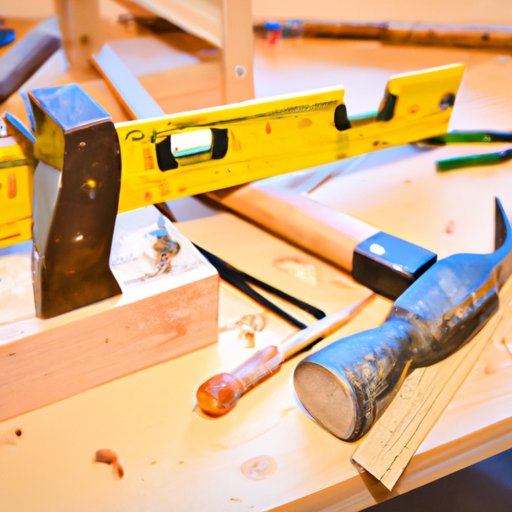
I. Introduction
If you are a DIY enthusiast or someone who loves woodworking, having a workbench is a must-have. A workbench is an indispensable tool for any handyman, as it provides a stable and spacious surface for working on any project, whether it’s DIY or repair work.
If you’re interested in building your own workbench, this article will provide an in-depth guide, including step-by-step instructions, design ideas, cost breakdowns, safety tips, and a video tutorial, to help make your project a success.
II. Step-by-Step Guide
The first step in building a workbench is planning. Before you begin the actual construction, you need to decide on the dimensions, style, and materials that you will use. Once you’ve made these choices, you can begin building your workbench using our step-by-step guide.
Step 1: Create Your Design and Gather Materials
– Choose your preferred style and dimensions for the workbench.
– Create and refine your design using software.
– Gather all the materials needed for the project, including wood, screws, nails, glue, and finish.
Step 2: Build the Frame
– Cut the four legs and the two long beams to the dimensions you have chosen.
– Secure the long beams to the corresponding legs using screws.
– Add the short beams to the frame and attach them to the legs using screws.
Step 3: Build the Top
– Cut the wooden planks to the desired size and ensure they are level.
– Glue the planks together to form the workbench top.
– Attach the workbench top to the frame using screws.
Step 4: Add the Finishing Touches
– Apply any desired finish, such as paint, oil, or wax.
– Add any accessories that you might need, such as drawers, storage cabinets, or a vise.
– Test your workbench to make sure it is sturdy and functional.
III. Material List and Cost Breakdown
Before you begin building your workbench, it’s important to compile a list of all the materials you will need to complete the project. Here is a comprehensive list of materials along with their estimated costs:
- 2×4 lumber – $20
- 3/4″ plywood – $35
- Wood glue – $5
- Screws and nails – $15
- Finish – $20
- Tools (saw, drill, etc.) – $100
These costs may vary depending on your location, so be sure to check local hardware stores and online retailers for accurate pricing.
IV. Video Tutorial
If you’re a visual learner or prefer to see the steps in action, we’ve created a video tutorial that shows you every step of the building process. In the video, you’ll see verbal instructions and visual cues that make it easy for you to follow along and build your own workbench.
V. Design Ideas and Inspiration
There are many styles of workbenches to choose from, each with its own benefits and drawbacks. Here are some design ideas and inspiration to help you choose the workbench style that’s best for you:
- Rustic workbench – This simple and sturdy design is perfect for those who prefer a natural and rustic look.
- Mobile workbench – If you need to move your workbench around, a design with wheels is ideal.
- Multipurpose workbench – This design offers additional storage space, pegboards, and other features that help you stay organized.
VI. Safety Tips and Precautions
When building a workbench, it’s important to put your safety first. Here are some tips and precautions to follow:
- Always wear proper safety gear, including eye protection and gloves, when using power tools.
- Be mindful of your surroundings and keep others away from the work area when using power tools.
- Use caution when handling sharp tools or materials.
- Ensure your workbench is stable and secure before using it.
VII. Troubleshooting and FAQs
Here are the solutions to some common problems and FAQs that can arise while building a workbench:
- Q: What’s the best type of wood to use for a workbench?
A: Hardwoods such as maple, oak, or birch are the best choices for workbenches as they are strong and durable. - Q: Can I build my workbench without power tools?
A: Yes, you can use hand tools, but some power tools, such as a circular saw or drill, will make the process faster and easier. - Q: How much weight can a workbench hold?
A: This depends on the design and materials used, but a well-built workbench can typically hold up to several hundred pounds of weight.
VIII. Conclusion
Building a workbench is a fun and rewarding project that can bring many benefits to your DIY or woodworking projects. By following our step-by-step guide, watching our video tutorial, and using our design ideas and inspiration, you can create a sturdy and functional workbench that will last for years. Remember to follow safety precautions and be mindful of your surroundings while working on this project.




